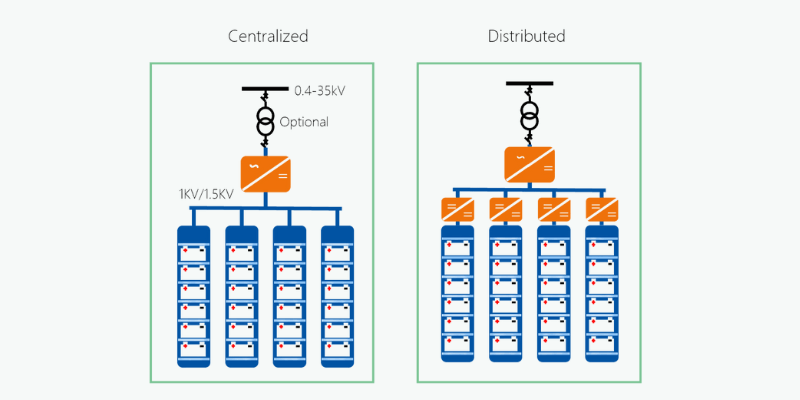Kryzys klimatyczny sprawił, że energia odnawialna stała się niezbędna, jednak transformacja stwarza wyzwania, szczególnie w zakresie magazynowania energii. Przed przyjęciem energii odnawialnej należy zbadać wydajne metody magazynowania, w tym systemy rozproszone i scentralizowane. Zrozumienie ich różnic i uzupełniających się ról jest niezbędne do wykorzystania zrównoważonej technologii.
Scentralizowany system magazynowania energii
Scentralizowany system magazynowania energii (CESS) koncentruje energię w jednym miejscu. Aby korzystać z energii odnawialnej z takiego systemu, należy podłączyć dom lub samochód kempingowy do sieci przechowującej i dystrybuującej zieloną energię. Technologia ta wychwytuje nadmiar energii w okresach niskiego zapotrzebowania i uwalnia ją w godzinach szczytu.
Stosowanie CESS ma wyraźne zalety:
- Przedsiębiorstwa użyteczności publicznej mogą szybko reagować na niedobory lub przepięcia, utrzymując stabilność sieci. Na przykład, jeśli panele słoneczne mają słabą wydajność, scentralizowana sieć może dostarczyć zmagazynowaną nadwyżkę energii.
- Scentralizowane przechowywanie przynosi korzyści skali, umożliwiając opłacalne operacje na dużą skalę.
Istnieją jednak wady CESS:
- Straty energii występują podczas procesów magazynowania i odzyskiwania, a niektóre metody, takie jak magazynowanie w elektrowniach wodnych, mogą powodować zakłócenia ekologiczne.
- Budowa scentralizowanej infrastruktury wiąże się z wysokimi kosztami początkowymi i bieżącymi wydatkami na utrzymanie, które ostatecznie ponoszą konsumenci.
- Scentralizowana infrastruktura, zwłaszcza elektrownie wodne, może szkodzić środowisku.
- Scentralizowane systemy można szybko zdemontować, a ich przywracanie po klęskach żywiołowych jest powolne.
Pomimo tych wyzwań scentralizowany system magazynowania energii ma kluczowe znaczenie dla zrównoważenia podaży i popytu w nowoczesnych sieciach elektroenergetycznych przy jednoczesnej integracji źródeł odnawialnych, ale nie jest to jedyna dostępna opcja.
Rozproszony system magazynowania energii
Alternatywą dla systemów scentralizowanych są systemy rozproszone, które składają się z małych jednostek instalowanych w różnych lokalizacjach.
Rozproszony system magazynowania energii (DESS) zazwyczaj wykorzystuje akumulatory litowo-jonowe do wydajnego magazynowania energii. Dobrze współpracują z lokalnymi źródłami odnawialnymi, takimi jak panele słoneczne i turbiny wiatrowe, przechwytując nadmiar energii do późniejszego wykorzystania. Zapewnia to niezawodną energię elektryczną nawet wtedy, gdy źródła odnawialne są nieaktywne.
Chociaż DESS zwiększa niezawodność lokalnej energii i zmniejsza zależność od centralnej siatki, może mieć ograniczoną pojemność w porównaniu z systemami scentralizowanymi.
Możesz zaimplementować system hybrydowy, który przechwytuje, przechowuje energię niezależnie, łącząc się z centralnym źródłem. Jeśli wolisz pełną niezależność, możesz dostosować pojemność magazynową w oparciu o sprzęt.
Jednak proces wydobycia litu zaawansowanej technologii akumulatorów może powodować szkody ekologiczne. Upewnij się, że dostawcy VET; Firmy takie jak Holo Bateria współpracują z odpowiedzialnymi górnikami litowymi, którzy przestrzegają najlepszych praktyk, aby zminimalizować wpływ na środowisko.
Wniosek
Przejście na energię odnawialną jest korzystne, ale sukces zależy od integracji odpowiedniej infrastruktury dla Twoich potrzeb.
Podejście hybrydowe może zapewnić niezależność energii podczas zarządzania ryzykiem, a rozproszone systemy magazynowania energii są idealne do aplikacji mobilnych. Niezależnie od tego, w jaki sposób wybierzesz, ważne są wysokiej jakości, wydajne baterie.
W przypadku niezawodnych baterii rozważ pracę z najlepszym producentem, takim jak Holo Bateria. Holo Bateria projektuje zaawansowane rozwiązania litowo-jonowe dostosowane do systemów rozproszonych lub hybrydowych, zapewniając długowieczność i wydajność. Zespół obsługi klienta doskonałego pomoże Ci w konfigurowaniu i utrzymaniu systemu energetycznego w celu skutecznego zaspokojenia twoich potrzeb.
Skontaktuj się z baterią Holo już dziś dla niestandardowych rozwiązań pamięci.

